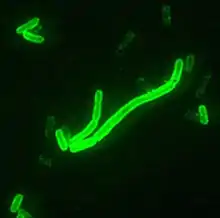| Great Plague in the late Ming dynasty | |
|---|---|
 Yersinia pestis | |
| Disease | Plague |
| Bacteria strain | Yersinia pestis |
| Location | Ming dynasty, China |
| First outbreak | Shanxi Province |
| Index case | 1633 |
Deaths | 200,000+ |
The Great Plague in the late Ming dynasty (Chinese: 明末大鼠疫; pinyin: Míngmò Dàshǔyì), also known as the North China Plague in the late Ming dynasty (simplified Chinese: 明末华北鼠疫; traditional Chinese: 明末華北鼠疫; pinyin: Míngmò Huáběi Shǔyì), or the Great Plague of Jingshi (Chinese: 京师大鼠疫; pinyin: Jīngshī Dàshǔyì), was a major plague epidemic between 1633 and 1644, the last phase of the Ming dynasty in China, during the Chongzhen Emperor's reign (1627–1644).[1][2] The epidemic started in Shanxi Province in 1633, and reached Beijing in 1641, where the plague caused the deaths of more than 200,000 people in 1643, directly contributing to the collapse of the Ming dynasty in 1644.[1][2][3]
History
In 1633, during the sixth year of Chongzhen’s reign, the plague epidemic started in Shanxi Province.[2]
In 1641, the plague arrived in Beijing, capital of the Ming dynasty.[2] At the same time, historical records indicate that more than half of the population in northern Zhejiang fell ill in 1641, and 90% of the local people died in 1642.[4]
In 1643, the epidemic reached its peak, killing more than 200,000 people in Beijing alone, accounting for 20%-25% of the local population.[1][3] The “pimple plague” and “vomit blood plague,” recorded in Chinese literature at the time, were possibly bubonic plague and pneumonic plague.[1][2]
In March 1644, Beijing was under siege by Li Zicheng's troops, whereas the defending force in Beijing weakened significantly due to the plague, with some 50,000 soldiers left–down from the original 100,000.[3] Soon, Li won the Battle of Beijing and the Chongzhen Emperor committed suicide, marking the end of the Ming dynasty,[1][2][3] although Li was subsequently defeated in the Battle of Shanhai Pass by the allied forces of the former Ming general Wu Sangui and the Manchu-led Qing dynasty.
Wu Youke (1582–1652) developed the idea that some diseases were caused by transmissible agents, which he called Li Qi (戾气 ''violent qi energy'') when he observed various epidemics rage around him between 1641 and 1644.[5] His book Wen Yi Lun (瘟疫论,Treatise on Pestilence/Treatise of Epidemic Diseases) can be regarded as the main etiological work that brought forward the concept.
See also
References
- 1 2 3 4 5 Ch’iu, Chung-lin. "The Epidemics in Ming Beijing and the Responses from the Empire's Public Health System". 中央研究院歷史語言研究所集刊: 331–388.
- 1 2 3 4 5 6 Cao, Shuji. "鼠疫流行与华北社会的变迁 ( 1580—1644 年)" (PDF). 历史研究 (in Chinese) (1) – via China Academic Journal Electronic Publishing House.
- 1 2 3 4 "专家谈明朝灭亡:鼠疫或为重要原因". China News Service (in Chinese). 2013-12-03. Retrieved 2021-01-18.
- ↑ Brook, Timothy (September 1999). The Confusions of Pleasure: Commerce and Culture in Ming China. University of California Press. ISBN 978-0-520-22154-3.
- ↑ Joseph, P Byre (2012). Encyclopedia of the Black Death. ABC-CLIO. p. 76. ISBN 978-1598842548. Retrieved 24 February 2019.